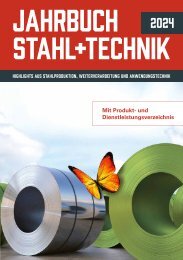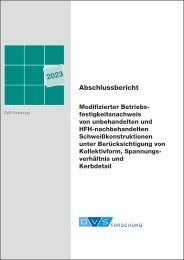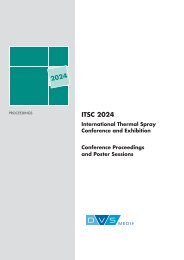STEEL + TECHNOLOGY 04/2019 EXTRACT
STEEL + TECHNOLOGY 04/2019 EXTRACT
STEEL + TECHNOLOGY 04/2019 EXTRACT
Create successful ePaper yourself
Turn your PDF publications into a flip-book with our unique Google optimized e-Paper software.
<strong>STEEL</strong> <strong>TECHNOLOGY</strong> | 67<br />
Figure 4. With SST software for material tracking, the surface inspection results of different production lines are brought together in<br />
precise positions (Picture: SST)<br />
tage of this approach is the quick and<br />
cost-effective improvement of these<br />
existing systems. The classifier performance<br />
is evaluated and optimized in<br />
close cooperation with the customer during<br />
production.<br />
Furthermore, unlike many traditional<br />
methods, the increase in data volume<br />
when using deep learning technology frequently<br />
leads to an improvement in the<br />
classification result. While users of classical<br />
systems sometimes find it frustrating<br />
when no improvement of the classification<br />
is observed after adding a larger amount<br />
of data, deep learning systems can always<br />
be improved by the addition of training<br />
data. In order to alleviate a deep learning<br />
classifier’s confusion of two similar defect<br />
categories, it is often sufficient to simply<br />
increase the number of representative<br />
images of those two categories within the<br />
training set.<br />
Various production lines<br />
In most plants, multiple independent<br />
surface inspection systems can be found<br />
along each production line (figure 4), and<br />
in some cases, provisioned by multiple<br />
suppliers. While a few manufacturers<br />
have made efforts to compare performance<br />
across plants and production<br />
lines, many surface inspection systems<br />
are evaluated completely independently.<br />
In particular, classification systems within<br />
a single plant do not communicate with<br />
other upstream or downstream classification<br />
systems. This lack of communication<br />
prevents feedback loops that would<br />
improve classification results, for example,<br />
one system communicating<br />
high-probability shell defect classifications<br />
to a downstream production line.<br />
Additionally, global coil information, e.g.<br />
that a high rate of non-metallic inclusions<br />
was observed on a certain coil in a previous<br />
processing step, improves classification<br />
in later production lines.<br />
Smart Steel Technologies offers flexible<br />
material tracking software that<br />
References<br />
[1] Neogi, N.; Mohanta, D. K.; Dutta, P. K.: Review<br />
of vision-based steel surface inspection systems,<br />
EURASIP J. Image Vide. 2014:50, 2014<br />
[2] Krizhevsky, A.; Sutskever, I.; Hinton, G.E.: Imagenet<br />
classification with deep convolutional neural<br />
networks, NeurIPS, 2012, pp. 1097 – 1105<br />
[3] He, K.; Zhang, X.; Ren, S.; Sun, J.: Delving deep<br />
into rectifiers: Surpassing human-level performance<br />
on imagenet classification, Proc. IEEE<br />
Comput. Soc. Conf. 2015, pp. 1026 – 1034<br />
[4] Masci, J.; Meier, U.; Ciresan, D.; Schmidhuber,<br />
J.: Fricout, G.: Steel defect classification with<br />
max-pooling convolutional neural networks,<br />
IJCNN 2012, pp. 1 – 6<br />
[5] Masci, J.; Meier, U.; Fricout, G.; Schmidhuber, J.:<br />
Multi-scale pyramidal pooling network for generic<br />
steel defect classification, IJCNN 2013, pp. 1 – 8<br />
[6] Yi, L., Li, G.; Jiang, M.: An End-to-End Steel Strip<br />
Surface Defects Recognition System Based on<br />
allows combining inspection results<br />
from different systems even in extreme<br />
cases. The defect positions are accurately<br />
superimposed taking into account<br />
strip position transformations, cropping<br />
and trimming shears as well as the cutting<br />
and welding of coils (figure 4). This<br />
enables the detected defects of all relevant<br />
surface inspection systems to be<br />
viewed together in one central coil map,<br />
as well as the SST classifiers to access<br />
the inspection results of upstream production<br />
lines, resulting in improved classification<br />
results.<br />
Convolutional Neural Networks, Steel Res. Int.<br />
88(2), 1600068, 2017<br />
[7] Zhou, S.; Chen, Y.; Zhang, D.; Xie, J.; Zhou, Y.:<br />
Classification of surface defects on steel sheet<br />
using convolutional neural networks, Mater.<br />
Technol. 51(1), 2017, pp. 123 – 131<br />
[8] Arikan, S.; Varanasi, K.; Stricker, D: Surface<br />
Defect Classification in Real-Time Using Convolutional<br />
Neural Networks, arXiv:19<strong>04</strong>.<strong>04</strong>671,<br />
<strong>2019</strong><br />
[9] Kostenetskiy, P.; Alkapov, R.; Vetoshkin, N.;<br />
Chulkevich, R.; Napolskikh, I.; Poponin, O.: Real-<br />
Time System for Automatic Cold Strip Surface<br />
Defect Detection, FME Transactions 47, <strong>2019</strong>, pp.<br />
765 – 774<br />
[10] Song, K.; Yan, Y.: A noise robust method based<br />
on completed local binary patterns for hot-rolled<br />
steel strip surface defects, Appl. Surf. Sci. 285,<br />
2013, pp. 858 – 864<br />
<strong>STEEL</strong> + <strong>TECHNOLOGY</strong> 1 (<strong>2019</strong>) No. 4


















